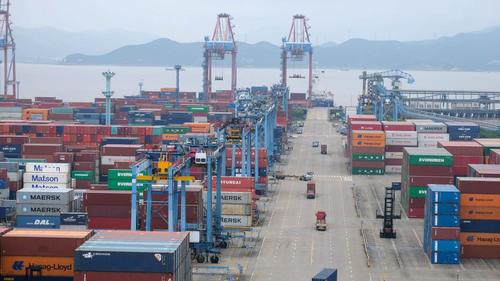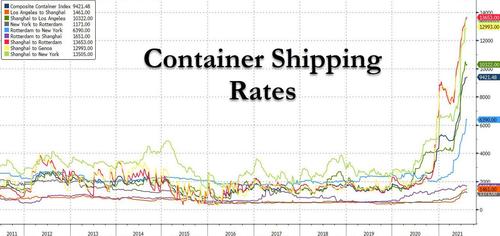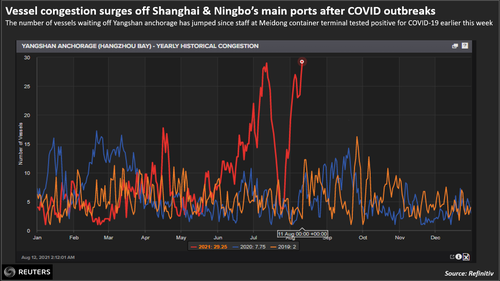Shippers Frantic After China’s Busiest Port Shuts Container Terminal Due To Covid
We recently discussed how already astronomical container shipping costs are set to rise even higher should China lock down one or more shipping terminals to contain the spread of the delta variant in provinces that have direct exposure to global commerce (“Shipping Rates From China To US Hit Record $20,000 With No Drop In Sight” and “Brace For Astronomical Shipping Costs As China Goes Into Lockdown Mode“) with Goldman Sachs explicitly warning that “port closures or stricter control measures at ports could also put further upward pressure on shipping costs, which are already very high.”
It now looks that this worst case scenario is in play after Chinese authorities on Wednesday closed a major container terminal at the Port of Ningbo after a dock worker tested positive for COVID, raising fears among traders that supply chain disruptions that occurred when Yantian terminal in Shenzhen reduced output by 70% for a month earlier this summer would be repeated.
According to FreightWaves which cited local media reports and logistics operators, all operations at the Ningbo Meidong Container Terminal, also referred to as the Meishan Terminal, were immediately suspended following the positive test results.
“With this sudden suspension, we expect a delay in planned sailings that might affect your cargo planning. Please know that we are working on alternatives, and hope for your understanding on a matter that is beyond our control,” German vessel operator Hapag-Lloyd said in a customer notice posted on its website, anticipating the howls of rage as already stratospheric shipping rates are poised to surge.
There are five container terminals in Ningbo. The port’s decision to shut down vessel and gate operations for at least a day effectively eliminated 20% of the port’s capacity.
Ningbo is the third-largest container port in the world after Shanghai and Singapore, but the most . It handled more freight in the first seven months of this year – 18.7 million twenty-foot equivalent units – than any other port in China, the Ministry of Transportation said last week.

The consequences of the shutdown are already apparent: on Thursday, Mediterranean Shipping Co. pushed back estimated arrival times for two vessels departing Ningbo to the U.S. The MSC Danit, on the Sequoi service, is now scheduled to arrive on the U.S. west coast on Sept. 15, and the Maersk Seville, on the Lone Star service and part of the 2M Alliance, will arrive at its first east coast port on Oct. 2, according to an updated schedule issued Thursday.
With vessels rerouted to Shanghai, ports in the area are experiencing a fresh burst of congestion, with about 30 vessels waiting on anchor at the Yangshan port. The chart below from Refinitiv shows vessel congestion in Shanghai & Ningbo’s main ports.
If the outbreak spreads and authorities take further steps to lock down, the impact potentially could be greater than what happened at Yantian in late May and June according to FreightWaves. The limited activity in Yantian forced vessels to wait more than a week to reach a berth and created ripple effects worldwide. Many vessels skipped Yantian for other ports in south China, creating massive congestion in those locations. Backlogged shipments took weeks to clear from the docks and are still being pulled from warehouses and factories, upsetting delivery schedules for retailers and manufacturers.
“If something goes sideways in Ningbo, it’s going to be a real problem. At least as big, potentially, as what happened in Yantian,” a sea freight executive at a large logistics company said during a customer briefing American Shipper was privy to.
The freight forwarding division of C.H. Robinson told customers in an email notice to expect port delays and congestion.
Any lengthy closure could result in cargo diversion to other terminals and ports, putting a strain on their operations and exacerbating capacity challenges that have led to record shipping rates 10 times greater than normal for certain routes.
As Michael Every concluded in his daily note this morning, Delta is leading to further disruption to shipping at China’s busiest ports, and even Vietnamese and Thai production are being impacted by the virus. In short, shipping snarls are going to get worse. Anecdotes are of shippers telling clients they will not deliver except at a premium; of smaller firms, and countries, being pushed down the priority list; of ships refusing to pick up goods exports from some locations; and of a structural supply-demand mismatch of sought-after shipping containers.
It is against this backdrop that another supply-chain snafu is emerging, and unless contained quick, could lead to a dramatic deterioration in global shipping logistics just as optimism was emerging that the historic logjam was set to normalize by early 2022.
Tyler Durden
Thu, 08/12/2021 – 22:25
via ZeroHedge News https://ift.tt/3yI4dxn Tyler Durden

